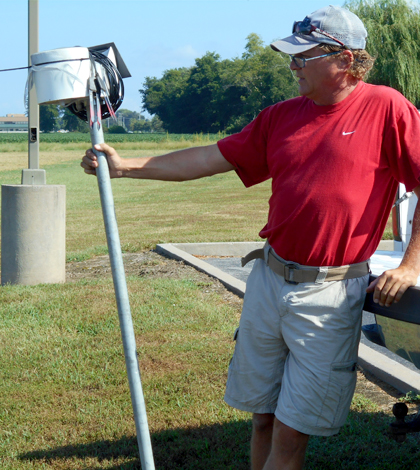Southeast Missouri State Installs Soil Sensors For Students, Farmers

Damon Dowdy of Below Ag Service demonstrates how the new soil moisture sensors will operate. (Credit: Southeast Missouri State University)
Michael Aide is the chairman of Southeast Missouri State University’s Department of Agriculture, and he is experimenting with a piece of equipment that could conserve precious groundwater resources, save growers money and teach students about various aspects of on-the-farm water management.
That piece of equipment is a soil electronic sensor system made by Pessl Instruments. It was installed at Southeast Missouri State University’s David M. Barton Agriculture Research Center in July of 2015 and then at the university’s Sikeston campus in September.
The Missouri Bootheel, where this research is taking place, is the southeastern-most part of the state. The Bootheel is situated in an alluvial basin, which is where soil is created by rivers depositing all kinds of sediment including sand, silt and clay. This means that farmers in the region “have all soil types imaginable,” according to Aide, and so must tailor their irrigation plans to the type of soil they have to work with.
Of course there are many ways that a farmer can irrigate a field, but two tend to work best in the Bootheel according to Aide: “…furrow irrigation where we use poly-pipe to trickle water on a graded land down between the rows and the other is center-pivot irrigation.” The soil electronic sensor system is used in concert with a center-pivot irrigation system, but it is still important to understand when a grower would choose to use this type of system over furrow irrigation in the first place.
When considering how to irrigate a field, Aide takes two variables into consideration — soil texture and field size. If a soil has a heavy texture, then it has a higher proportion of small particles like silt or clay than large particles like sand. Since small particles settle close to one another with small pores between them, water moves slowly through these types of soil. In contrast, light-textured soils have higher proportions of large particles like sand than small particles like silt or clay. This causes the soil particles to settle with large pores between them, allowing water to move more quickly through the soil.
Soil texture is a potential barrier to proper irrigation because if a grower were to use furrow irrigation on a light-textured soil, most of the water would drain right through at the beginning of the field before it got a chance to move horizontally to the other side. For this reason, Aide tends to use furrow irrigation on heavily textured soils and center-pivot irrigation on light-textured soils. The other variable he considers is field size. If a field is too large, then the time it would take for a 200-meter center-pivot apparatus to complete a rotation would be prohibitively long.
The machine in question has five components. The first is a solar panel that provides the energy needed to keep the sensors working. Next, a transmitter sends the data to a satellite so they can be retransmitted to a computer or smartphone. The actual data-collecting parts of the instrument include soil temperature and moisture probes at 6, 12, 18 and 24 inches, a rain gauge and an air temperature probe.
The data are collected every hour and monitored daily. Once they are sent to a computer or smartphone, the accompanying software can estimate soil water evaporation, disease and insect growth potentials and net photosynthesis. Aide noted that having all of that information, along with the ability to turn the water on and off, at his fingertips is convenient, “But there’s no substitute for visiting your field and monitoring your field.”
Given that “60 percent of the acreage of the Bootheel is irrigated,” as Aide said, it is easy to assume that producers in the area routinely experience depleted aquifers. This, however is not necessarily the case, says Aide.
“In Southeast Missouri we are one of the few areas where we actually have an abundance of aquifer water to the point that we actually, for the most part, have too much water,” said Aide, which isn’t true everywhere. “But immediately south of us in the state of Arkansas, they have substantial overdraft issues and therefore these kinds of technologies will mitigate using water uneconomically.”
Regardless of how close a particular grower’s water table is to the soil surface, irrigating a field always requires energy and money. Aide addressed this issue by stating that, “What we desire is to be able to irrigate efficiently so that we don’t water too frequently, which is a problem and we don’t over-irrigate at any one time, which can also be a problem.”
Aide says the sensors and software system also have applications in the classroom. “One might be water management where we simply teach them (students) how to use the irrigation. But the other might be in crop physiology where we’re trying to show them how water influences photosynthesis that then drives yield,” he said.
But the real benefits come through temperature and moisture data that can be fed into plant disease and pest models to predict outbreaks. “What it really gives the grower is they start understanding the water dynamics in their own soils without them having to become soil physicists,” said Aide.
Top image: Damon Dowdy of Below Ag Service demonstrates how the new soil moisture sensors will operate. (Credit: Southeast Missouri State University)




0 comments